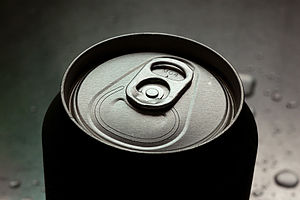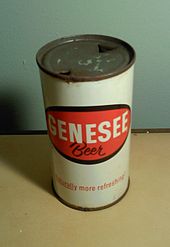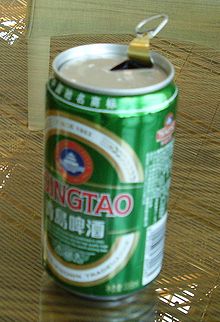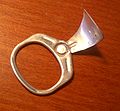- Beverage can
-
"pop top" redirects here. For the software company, see PopTop Software."pop cap" redirects here. For the software company, see PopCap Games.
A beverage can is a tin can designed to hold a specific portion of a beverage. Beverage cans are made of tin-plated steel or aluminium.
Contents
History
See also: tin can#HistoryThere were once cans in the United States called cone tops and crowntainers which had tops that were conical, rather than flat. Cone top cans were sealed by the same caps that were put on bottles. There were three types of conetops: high profile, low profile, and j-spout. The low profile and j-spout were the earliest, dating from about 1935, the same as the flat top cans that had to be opened with an opener. The crowntainer was a different type of can that was drawn steel with a bottom cap and the favorite of some collectors. Various breweries used crowntainers and conetops until the late 1950s, but not every brewery used every variety mentioned above. Crowntainers were developed by Crown Cork & Seal, now known as Crown Holdings, Inc., a leading beverage packaging and beverage can producer. This design returned to use in 2008 for packaging Coca-Cola's Caribou Coffee beverage.
Standard sizes
Comparison chart of various standards ml imp fl oz U.S. fl oz 1,000 35.2 33.8 500 17.6 16.9 (one U.S. pint) 473 16.6 16.0 440 15.5 14.9 375 13.2 12.7 355 12.5 12 350 12.3 11.8 330 11.6 11.2 237 8.3 8.0 200 7.0 6.8 Capacity
Various standard capacities are used throughout the World.
- Australia
- In Australia the standard can size is 375 ml.
- Europe
- In most of Europe standard cans are 330 ml.
- In some European countries there is a second standard can size, 500 ml, often used for beer, cider and energy drinks.
- India
- In India standard cans are 330 ml.
- Japan
- In Japan the most common sizes are 350 ml and 500 ml. Larger and smaller cans are also sold.
- North America
- In North America, the standard can size is 12 U.S. fl oz or 355 ml.
- South Africa
- South African standard cans are 330 ml and the promotional size is 440 ml. A smaller 200 ml can is used for "mixers" such as tonic or soda water. It is has a smaller diameter than the other cans.
- China
- In China the most common size is 330 ml.
Dimensions
Cans come in varying heights and diameters to encompass the range of capacities currently in use, however the diameters are usually one of two standard sizes. Canada, the United States, Australia and New Zealand almost universally use a diameter slightly in excess of 65 mm. This size is almost universal in these countries for soft drinks, beers and ready-mixed spirit drinks. European countries mostly use a much narrower size of 52 mm for soft drinks and some beers.[1] Recently the European size has started to appear in the US and Australasian markets with the appearance of energy drinks such as Red Bull (which is of European origin).
One practical difficulty brought about by these two differing standard sizes is that cars manufactured in Europe (with the smaller size cans and holders) and exported to the US or Australia (who use the larger size) often present their owners with cup holders that are incapable of holding most drinks in those countries.
Composition
Most metal beverage cans manufactured in the United States are made of aluminium,[2] whereas in some parts of Europe and Asia approximately 55 percent are made of steel and 45 percent are aluminium alloy. Steel cans often have a top made of aluminium.
An empty aluminium can weighs approximately half an ounce (15 g). There are roughly 30 empty aluminium cans to a pound or 70 to a kilogram.
In many parts of the world a deposit can be recovered by turning in empty plastic, glass, and aluminium containers. Scrap metal dealers often purchase aluminium cans in bulk, even when deposits are not offered. Aluminium is one of the most cost-effective materials to recycle. When recycled without other metals being mixed in, the can–lid combination is perfect for producing new stock for the main part of the can – the loss of magnesium during melting is made up for by the high magnesium content of the lid. Also, reducing ores such as bauxite into aluminium requires large amounts of electricity, making recycling cheaper than producing new metal.
Many consumers find the taste of a drink from a can to be different from fountain drinks and those from plastic or glass bottles.[weasel words] In addition, some people believe that aluminium leaching into the fluid contained inside can be dangerous to the drinker's health.[3] Scientific consensus is that aluminium plays no role in the development of Alzheimer's disease.[4][5]
Aluminium cans often contain an internal coating to protect the aluminium from beverage corrosion. Despite this coating, trace amounts of aluminium can be degraded into the liquid, the amount depending on factors such as storage temperature and liquid composition.[6][7] Chemical compounds used in the internal coating of the can include types of epoxy resin.[8]
Filling cans
Cans are filled before the top is crimped on. The key engineering issue is that can walls are about 80 micrometers thick[citation needed], so empty cans are light, weak, and can easily be damaged. The filling and sealing operations need to be extremely fast and precise. The filling head centers the can using gas pressure, purges the air, and lets the beverage flow down the sides of the can. The lid is placed on the can, and then crimped in two operations. A seaming head engages the lid from above while a seaming roller to the side curls the edge of the lid around the edge of the can body. The head and roller spin the can in a complete circle to seal all the way around. Then a pressure roller with a different profile drives the two edges together under pressure to make a gas-tight seal. Filled cans usually have pressurized gas inside, which makes them stiff enough for easy handling.
Fabrication process
Modern cans are generally produced through a mechanical cold forming process that starts with punching a flat blank from very stiff cold-rolled sheet. This sheet is typically alloy 3104-H19 or 3004-H19, which is aluminium with about 1% manganese and 1% magnesium to give it strength and formability. The flat blank is first formed into a cup about three inches in diameter. This cup is then pushed through a different forming process called "ironing" which forms the can. The bottom of the can is also shaped at this time. The malleable metal deforms into the shape of an open-top can. With the sophisticated technology of the dies and the forming machines, the side of the can is significantly thinner than either the top and bottom areas, where stiffness is required. A single can-making production line can turn out up to 2400 cans per minute.[citation needed]
Plain lids are stamped from a coil of aluminium, typically alloy 5182-H48, and transferred to another press that converts them to easy-open ends. The conversion press forms an integral rivet button in the lid and scores the opening, while concurrently forming the tabs in another die from a separate strip of aluminium. The tab is pushed over the button, which is then flattened to form the rivet that attaches the tab to the lid.[citation needed]
Finally, the top rim of the can is trimmed and pressed inward or "necked" to form a taper conical where the can will later be filled and the lid (usually made of an aluminium alloy with magnesium) attached.[citation needed]
Opening mechanisms
Early metal beverage cans had no tabs; they were opened by a can-piercer or churchkey, a device resembling a bottle opener with a sharp point. The can was opened by punching two triangular holes in the lid—a large one for drinking, and a second (smaller) one to admit air.
As early as 1922, inventors were applying for patents on cans with tab tops, but the technology of the time made these inventions impractical.[9] Later advancements saw the ends of the can made out of aluminium instead of steel.
One potential problem with the current design is that the top edge of the can may collect dust or dirt in transit. Cans are usually in sealed paperboard cartons, corrugated fiberboard boxes, or trays covered with plastic film. The entire distribution system and packaging need to be controlled to ensure freshness.[10]
Pull-tab
Old style pull-tab in use on a can of Tsingtao beer in Beijing, China in 2009
Mikola Kondakow of Thunder Bay, Ontario, Canada, invented the pull tab version for bottles in 1956 (Canadian patent 476789). Then, in 1962, Ermal Cleon Fraze of Dayton, Ohio, invented the similar integral rivet and pull-tab version (also known as ring pull (British English), which had a ring attached at the rivet for pulling, and which would come off completely to be discarded. He received U.S. Patent No. 3,349,949 for his pull-top can design in 1963 and licensed his invention to Alcoa and Pittsburgh Brewing Company, the latter of which first introduced the design on Iron City Beer cans. The first soft drinks to be sold in all-aluminium cans were R.C. Cola and Diet-Rite Cola, both made by the Royal Crown Cola company, in 1964.
The early pull-tabs detached easily. The New England Journal of Medicine reported a case of one person ingesting a pull-tab that had broken off and dropped into the can.[citation needed] The design of the pull-tabs was addressed by Daniel F. Cudzik of Reynolds Metals, who in 1975 developed stay-tabs.[dead link][11][12][13]
Full-top pull-tabs were also used in some oil cans and are currently used in some soup, pet food, tennis ball, nuts and other cans.
Stay-on-tab
The stay-on-tab was designed by Daniel F. Cudzik for a Reynolds Metals Co. aluminium can.[13] This design reduced injuries and reduced roadside litter caused by removable tabs. The mechanism uses a separate tab attached to the upper surface as a lever to depress a scored part of the lid, which folds underneath the top of the can and out of the way of the resulting opening.[14]
Beverages like Pepsi began using this new type of tab in the United States by 1977.[15] Such "retained ring-pull" cans supplanted pull-off tabs in the United Kingdom in 1989 for soft drinks and 1990 for alcohol.[16] One of the more recent modifications to can design was Mountain Dew's introduction of the "wide mouth" can in the late 1990s.[citation needed]
Press button can
One unsuccessful variation was the press-button can, which featured two pre-cut buttons—one large and one small—in the top of the can[17], sealed with a plastic membrane. These buttons were held closed by the outward pressure of the carbonated beverage. The consumer would open the can by depressing both buttons, which would result in two holes. One hole would be used for drinking the beverage and the other would act as a vent for air passage. Consumers could also easily cut themselves on the edges of the holes or get their fingers stuck.
Press button cans were used by Pepsi in Canada from the 1970s to 1980s and Coors in the 1970s. They have since been replaced with pull tabs.
Collecting
Beer can collecting was a minor fad in the late 1970s and 1980s. However, as canned beer lost favor to bottled beer[clarification needed], the hobby waned rapidly in popularity. The Beer Can Collectors of America (BCCA), founded in 1970, was an organization supporting the hobby, but has now renamed itself Brewery Collectibles Club of America.[18] The BCCA originally took a stance in opposition to the buying and selling of cans and disallowing buying and selling at their meetings in favor of swapping cans. In response some rival beer can collecting clubs formed who allowed the buying and selling of cans at their meetings, the most significant of which was World Wide Beer Can Collectors (WWBCC). Eventually the BCCA dropped its ban on buying and selling cans, and the other clubs went out of business.
A number of books considered classics[citation needed] on the hobby were published during the heyday of the can collecting fad, many of them[which?] featuring color photos of thousands of cans.
As of late 2009, membership in the Brewery Collectibles Club of America was 3,570, down from a peak of 11,954 in 1978. Just 19 of the members were under the age of 30, and the members' average age had increased to 59.[19]
Media
See also
Notes
- ^ [1]
- ^ Turner, Terence (2001). Canmaking For Can Fillers. Boca Raton: CRC Press. pp. 23. ISBN 0-8493-9787-1.
- ^ Snopes.com
- ^ "Ask The Experts: Medicine - Is there any proof that Alzheimer's disease is related to exposure to aluminium--for instance, by using aluminium frying pans?". Scientific American (Scientific American, Inc.). 1997-07-14. Archived from the original on October 12, 2007. http://web.archive.org/web/20071012142257/http://www.sciam.com/askexpert_question.cfm?articleID=0000FCD2-AA88-1C71-9EB7809EC588F2D7&ref=sciam. Retrieved 2006-10-05.
- ^ "ToxFAQs for aluminium". U.S. Center for Disease Control, Agency for Toxic Substances and Disease Registry, Information Center. June 1999. CAS# 7429-90-5. http://www.atsdr.cdc.gov/tfacts22.html. Retrieved 2006-10-05.
- ^ Vela, M.; Toma, R. B.; Reiboldt, W.; Pierri, A. (1998). "Detection of aluminum residue in fresh and stored canned beer". Food Chemistry 63 (2): 235–037. doi:10.1016/S0308-8146(97)00236-7.
- ^ Lopez, F.; Cabrera, C.; Lorenzo, M. L.; López, M. C. (2002). "Aluminium content of drinking waters, fruit juices and soft drinks: contribution to dietary intake". The Science of the Total Environment 292 (3): 205–213. doi:10.1016/S0048-9697(01)01122-6. PMID 12146520.
- ^ "Precoating of aluminium can sheet - Patent 3832962". www.freepatentsonline.com. http://www.freepatentsonline.com/3832962.html. Retrieved 2009-07-20.
- ^ "Prototype tab tops". Retrieved on 2009-04-25.
- ^ Singh, S. P.; Gorzynski (July 1989). "Effect of Vibration as a Cause of Leakage in aluminium Beer Cans in Palletized Loads". J. Testing and Evaluation 26 (4).
- ^ Speech to the University of Illinois Senior 100 on April 25, 1999. Retrieved on 2007-07-22.
- ^ Pop can top (Public Radio Commentary), William S. Hammac, 2001, retrieved 20 July 2010
- ^ a b The Stay-On-Tab Designed by Dan Cudzik on a Reynolds Metals Co. aluminium Can, circa 1975, Virginia Historical Society, Library of Virginia, retrieved 20 July 2010
- ^ Easy-Open Wall, U.S. patent no. 3,967,752 1976-07-06
- ^ PEPSI-Cola-355mL-HAVE A PEPSI DAY / N-United States, CanMuseum.com
- ^ http://www.canmakers.co.uk/education/history_of_the_can.asp
- ^ http://sodacancollection.blogspot.com/2011/08/o-canada.html
- ^ "Brewery Collectibles Club of America - Club History". http://www.bcca.com/history/overview4.php.
- ^ David Kesmodel (December 9, 2009). "Behold the Beer Can, Its Beauty Faded in the Eyes of the Young". Wall Street Journal. http://online.wsj.com/article/SB126022528798380825.html?mod=rss_Today%27s_Most_Popular.
References
- Brody, A. L., and Marsh, K, S., "Encyclopedia of Packaging Technology", John Wiley & Sons, 1997, ISBN 0-471-06397-5
- Soroka, W, "Fundamentals of Packaging Technology", IoPP, 2002, ISBN 1-930268-25-4
External links
Categories:- Beer vessels and serving
- Containers
- Packaging
Wikimedia Foundation. 2010.





